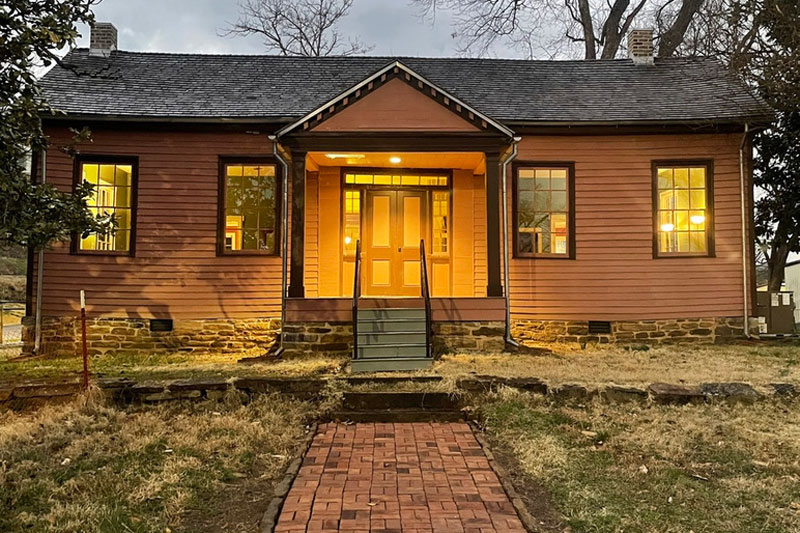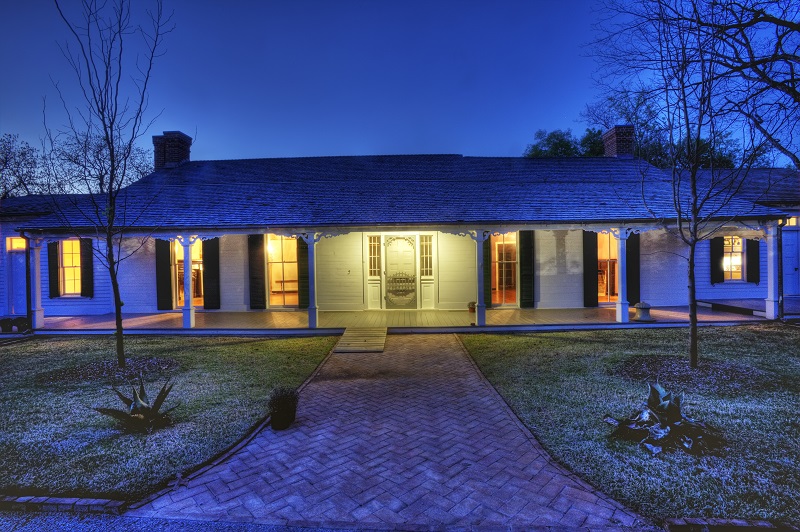Drennen-Scott Historic Site
Drennen-Scott House
Front exterior of the Drennen-Scott House as seen at night.
Born to an Irish immigrant who fought in the American Revolution, John Drennen left home in Elizabeth, Pennsylvania, as soon as he became “of age.” He first found opportunity and a new wife and family in Nashville, Tennessee, marrying Emily Dederick Stuart, a widow with whom he had three children. While in Nashville, he partnered with his brother-in-law, David Thompson, and operated a mercantile store near the Tennessee state capital. Drennen fostered business and personal relationships with notable historical figures like Sam Houston and James K. Polk.
Always looking to better their situation, Drennen and Thompson moved their store to Little Rock in the mid-1820’s, but soon pushed further west to Crawford County in search of more lucrative opportunities.
In 1836, Thompson and Drennen, considered now to be the founders of Van Buren, Arkansas, purchased almost 600 acres on the north bank of the Arkansas River in Crawford County, including a small village named Phillips Landing. Thompson died the next year and did not see the development of the town, but before his death, the two platted the future streets and advertised in the Arkansas Gazette newspaper to attract developers and people to populate the new town. With no bridge across the river, Drennen quickly secured a ferry business, which moved agricultural products, U.S. mail, and the Butterfield Stage to Fort Smith and beyond. In those days, Crawford County was one of the largest in the state and included parts of Washington and Sebastian counties as well as land that is today Oklahoma.
Also in 1836, Drennen represented Crawford County at the convention to join the United States and served in the first state legislature in 1837. His efforts to have Van Buren named county seat were rewarded after he donated a square block in the town for the courthouse, which was constructed in 1842. He continued to promote civic development in the city by donating 10 acres for Fairview Cemetery. His business ventures brought many steamboats to Crawford County and helped connect the area to the population centers back east. Goods, products, information, and news all came by steamboat and were dispersed through the new town of Van Buren. Drennen also saw the future benefit of railroads and became a founding stockholder of the Little Rock and Fort Smith Railroad, tracks that are still used today.
While Drennen’s fingerprints are on much of the county and still visible today, his story is not always positive. Drennen owned land in 27 counties in Arkansas, foreclosures he bought for cents on the acre after recovery by the real estate bank of which he was a board member. He was brought into court numerous times on behalf of his shady bank practices and land transactions.
Drennen operated a cotton plantation in Chicot County that included 1,000 acres of some of the best farmland in Arkansas, holding nearly 100 slaves to work his fields. He also had 10-15 domestic servants held in bondage at his home in Van Buren, including a body servant (butler, carriage driver, body guard) named Patrick. Through research it was discovered that Patrick Drennen is buried in the Drennen-Scott family plot at Fairview Cemetery. Today his living descendants regularly contribute to the historical interpretation of the site, enriching our understanding of the complexities of the past and helping us to consider all perspectives of the Drennen-Scott story.
Another negative aspect to the story was Drennen's selection to serve as Indian agent to the Choctaw Nation in 1849. He was promoted to superintendent of Indian Affairs for the region in 1851, giving him authority over the Five Tribes and others. This appointment made Drennen an instrument of federal Indian policy as he dealt with some of the consequences of the Trail of Tears, a time of tragedy and loss for Native Americans.
The Drennen-Scott site also documents the second-class nature of women for much of its history and the difficulties faced by women to fit into a world where men had greater status. Through this perspective we can consider the positive and negative aspects of our collective past and hopefully find ways to heal and learn from the events and people.
Through grant funding, UAFS purchased the remaining 36 acres of the original transaction in 2005, including Drennen’s house, built in 1838 and handed down through his family for five generations. Since acquiring the property, the house and ground have been meticulously preserved and restored, transforming it into a museum and educational facility. Students of all ages have studied, researched, served as interns, published articles, and participated in educational programs aimed at honoring and understanding the complexities of the past. As a public museum, the Drennen-Scott House contributes to the local and regional heritage tourism economy, engaging the public in all aspects of the story.
The site has won awards for historic preservation and has been recognized by the governor for contributions to tourism. The staff has received awards for historic preservation education and for promoting and preserving the history of Arkansas.
The Drennen-Scott Historic Site is open April through November, hosts a monthly lecture series, and can be rented for special tours, meetings, and events.
Willhaf House

Front exterior of the Willhaf House.
Leonard Willhaf and his wife, Mary Beckel, were part of an early 19th-century wave of German immigrants to the United States. While it is believe that Willhaf came to Arkansas by way of St. Louis, his wife already had ties to Fort Smith through extended family, including the Reutzel clan. The Willhafs settled in Van Buren and owned a bakery. He was also a veteran of the Mexican-American war, serving as the flag bearer of the Crawford County Company of Archibald Yell's Mounted Rifles and eventually reaching the rank of lieutenant. The flag Willhaf carried was presented to the soldiers on the lawn of the Crawford County Courthouse in Van Buren by the ladies’ association who sewed it and is currently part of the collection of the Old State House.
Willhaf died in 1866 and is buried in Fairview Cemetery in Van Buren. After his death, Mary expanded their home to include additional rooms to board transient railroad workers, the foundation of which were recently revealed by on-site archeology work. After her passing, the home was sold and eventually occupied by Ora Smith, a history teacher in the Fort Smith Public School district and local historian of note. Smith lived in the Willhaf House for a number of years, securing it a National Register Nomination. She died without heirs, and the final owners of the house were John and Zoe Cobb, from whom Sandra Pearson and Melissa Wick inherited the property, eventually donating the home to UAFS for preservation and restoration.
Thanks to their donation plus $2.6 million in grants from the Arkansas Natural and Cultural Resources Counsel, Tom Wing, UAFS assistant professor of history, and John Mott, director of preservation for John Milner and Associates, conducted extensive historical research, engaging the Arkansas Archeological Survey, the Dendrochronology Laboratory at the University of Arkansas, Fayetteville, and a host of other preservation professionals to document and preserve original material and restore the property to the its 1850s appearance. One of the more interesting findings was a newspaper article from 1851 documenting the planting of a magnolia tree that still stands next to the house.
The home is open for tours and provides a sharp historical contrast from an interpretive standpoint, telling the story of a working-class immigrant family opposed to the elite and well-to-do Drennen-Scott family nearby. The site also includes a 19th-century vegetable garden maintained through a partnership between Americorps, Master Gardeners, and UAFS.
The Willhaf property helps complete the 19th-century interpretation of not only Van Buren but western Arkansas as well and is promoted by the Van Buren Advertising and Promotions Commission, aided by a partnership with the City of Van Buren for water and sewer upgrades as well as pedestrian sidewalks for visitor access. The property is available for special use rental, such as small group meetings and receptions.
Tom Wing
- Site Director
- Drennen-ScottFREEuafs
- 479-262-2750
- 10 a.m. to 4 p.m. Wednesday, Friday, and Saturday, April-November
- 221 N. 3rd St., Van Buren, Arkansas

